Growing Cucumbers Organically
|
© Steve Masley Click IMAGE to Enlarge |
Growing cucumbers is easy, even for inexperienced home gardeners. Cucumbers are a cool, crisp summer treat that have a place in every garden.
Cucumbers (Cucumis sativus) were domesticated in India, but are now grown globally. In the north, they’re grown as annual summer vegetables. They can be sliced and added to salads, or pickled in a sweet or tart brine with herbs to preserve them.
There are three primary types of cucumbers: Slicing, Pickling, and “Specialty”.
Slicing cucumbers are the long, straight cucumbers sold in stores, for fresh use. Pickling cucumbers are smaller, thicker, and bred for drier flesh, so they can soak up more pickling brine. “Burpless” cucumbers are bred to produce less gas in the stomach. For more information on Cucumber Varieties, click Here.
Cucumber Varieties
|
Growing Cucumbers in Containers
Harvesting Cucumbers
How to Grow Cucumbers
Where space allows, cucumbers can be grown in hills, and sprawl like summer squash, or planted along a trellis and trained vertically in smaller gardens.
Choose parthenocarpic cucumber varieties for growing cucumbers in greenhouses. Parthenocarpic cucumbers set fruit without need for pollination.
|
|
Cucumber Cold Tolerance/Season
Cucumbers and melons evolved in the tropics, and have very little cold tolerance. They die at the first touch of frost, and languish until daytime temperatures are in the 70’s If you’re growing cucumbers, don’t waste your time—and seeds—trying to plant them too early.
When growing cucumbers, start seeds indoors under lights 3-4 weeks before your last frost date, or buy seedlings from your local nursery. In either case, don’t set them out until daytime temperatures are in the 70’s (21-27° C) and nighttime lows in the 60’s (15-21° C).
Cold nights weaken cucumbers, and make them more susceptible to stem rots, bacterial and fungal wilts, and damage from snails, slugs, and insect pests.
Garden Preparation for Growing Cucumbers
|
Growing Cucumbers |
|---|
|
|
|
|
|
|
|
|
|
|
|
|
|
|
|
|
|
|
|
|
Cucumbers, like squash and melons, are heavy feeders, and perform best in a well-limed soil with good drainage and ample organic matter.
When growing cucumbers, prepare the soil to a depth of 18-24” (46-61cm), or single-dig to a depth of 9-10” (23-25cm), and mound soil up into hills to create a deep root zone.
Lay down a 2” (5cm) layer of good garden compost or composted manure when you prepare the lower soil layer. Mix it in, then lay down another 2” (5cm) layer and mix it in when you prepare the top of the hill.
If necessary, adjust the soil pH. Optimal pH for growing cucumbers is 6.5, or a slightly acidic soil. See Changing Soil pH for ways to adjust soil pH.
If your soil is lean or you’re short on compost, you can amend the soil with good organic fertilizer like Dr. Earth Organic Tomato, Vegetable and Herb Fertilizer.
This is a balanced (5-7-3) blend of fish meal and alfalfa meal for early-season growth, feather meal for mid- to- late-season growth, soft rock phosphate and fish bone meal for phosphorous, and kelp meal for potassium and boosting plant immunity. It also contains 7 strains of probiotic soil microbes, along with ecto- and endo-myccorhizae.
Mycorrhizae are beneficial soil fungi that all fruiting plants evolved with. Mycorrhizae help fruiting plants assimilate nutrients from the soil in much the same way human gut bacteria help people assimilate nutrients from our food.
For information on organic soil amendments, see the NPK Fertilizer page.
Top of Page
|
Varieties
|
Soil Preparation
|
Planting
Watering
|
Fertilizing
|
Plant Care
|
Pests
|
Diseases
Companion Plants
|
Growing in Containers
|
Harvesting
Planting Cucumbers
Cucumbers can be planted in widely-spaced hills like summer squash, or in rows along a trellis. Trellising produces straighter cucs without yellow “field marks” from fruit resting on the ground.
Cucumber Plant Spacing
If you’re growing cucumbers in hills, space the hills 6’ (2 meters) apart in all directions. Plant 6 seeds per hill, and thin to 3 plants per hill when the seedlings are 4” (10cm) high. If using seedlings instead of seeds, plant 3-4 seedlings per hill, and thin to the strongest 3 seedlings at 4” (10cm).
If you’re growing cucumbers in rows along a trellis, sow seeds 4-6” (10-15cm) apart along the base of the trellis, and thin plants to 12” (30 cm) apart when they’re 4” (10cm) high. Rows should be 3-4’ (1-1.3m) apart. The spacing between cucumbers is almost the same, whether you’re growing them in a single-dug bed, or a raised garden bed.
You can get away with a little tighter spacing between plants in a raised garden bed, but for the most part, the added soil depth will produce taller plants with bigger leaves, higher yields, and better fruit, but not much economy of space.
Top of Page
|
Varieties
|
Soil Preparation
|
Planting
Watering
|
Fertilizing
|
Plant Care
|
Pests
|
Diseases
Companion Plants
|
Growing in Containers
|
Harvesting
Care and Feeding of Cucumbers
Watering Cucumbers
Growing cucumbers requires regular, steady water, 1-1 ½” (4cm) per week. Cucumbers are relatively shallow-rooted, and the fruits are 90% water, so the soil should not be allowed to dry out while the plants are fruiting. Mulching helps even out soil moisture fluctuations, and prevents fungal spores from splashing up from the soil onto leaves and infecting them.
You can water cucumbers with a water wand or sprinkler (overhead watering) for the first 3 weeks after setting out plants, but once cucumbers start flowering and setting fruit, back off on the overhead watering and switch to drip irrigation.
If you do overhead watering, do it early in the day, so the foliage has time to dry before nightfall.
Defending leaves from pathogens becomes less of a priority once flowering and fruiting commences. Water on the foliage of mature summer vegetables—especially overnight—is an invitation to bacterial and fungal leaf diseases.
Fertilizing Cucumbers
If you build organic soil amendments into the soil before planting, you shouldn’t need any supplemental fertilizers. If you don’t, a side-dressing of composted manure or good garden compost a month after planting will boost yields. You can also use a good organic fertilizer like Dr. Earth Organic Tomato Vegetable Herb Fertilizer.
Cucumber Plant Care
Once the weather is warm and the plants have found something to climb on or ramble over, growing cucumbers doesn’t take a lot of work.
Watch for signs of disease or pest problems early in the season, and intervene quickly to prevent more severe problems down the road.
When growing cucumbers, be sure to harvest frequently once the plants are producing. Leaving overmature fruit with developed seeds on the vines shuts down new fruit set.
Top of Page
|
Varieties
|
Soil Preparation
|
Planting
Watering
|
Fertilizing
|
Plant Care
|
Pests
|
Diseases
Companion Plants
|
Growing in Containers
|
Harvesting
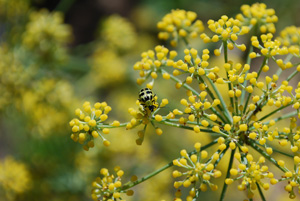
|
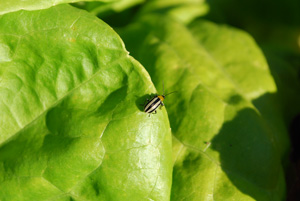
|
Cucumber Pests
Striped Cucumber Beetles and Spotted Cucumber Beetles are two of the most common pests when growing cucumbers. You are likely to see them.
They show up after plants are established and are growing vigorously. They’ll usually key in on one or two plants at first. Watch for them 2-3 weeks after you set out plants.
The last couple years, I’ve caught them as they were breeding, and smashed several mating pairs before they’ve laid eggs. For the rest of the season, I had no cuc pest problems. Luck and timing.
Aside from a few holes in leaves, cucumber beetles usually don’t do a lot of physical damage to the plants unless their numbers are large, but their larvae damage roots, and they can transmit bacterial wilts, mosaic virus, and other cucumber diseases.
Where infestations are heavy, use floating row covers to exclude cucumber beetles from your plants, or control with pyrethrin dust or rotenone.
Rotating crops helps prevent the buildup of pest populations that occurs when vegetables of the same plant family are planted in the same place year after year. This is particularly important for cucumbers, squash, melons, and other members of the cucurbit family. To see which vegetables are in the same plant families, see How to Grow Vegetables.
Spider Mites can sometimes attack cucumber leaves, especially cucumbers growing in containers. These tiny red mites spin fine webs around the edges of leaves, and suck juices from the plants by the hundreds or thousands.
They can be eliminated using a soap spray.
Cucumber Diseases
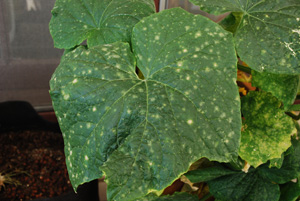
|
|
Pseudomonas syringae © Steve Masley Click IMAGE to Enlarge |
Early in the season, cucumber seedlings are subject to Stem Rots, where fungus attacks the stem near the base at the soil line. The plant stem softens, and the plant collapses and dies. This can happen with larger seedlings as well as seedlings that have just emerged.
Stem rots are more prevalent in cool, wet weather—another reason to wait for warmer temperatures before planting cucumbers.
Powdery and Downy Mildew often attack the leaves of cucumbers, squash, and other cucurbit family vegetables. White or grayish powdery patches show up on the leaves. The problem is more prevalent when water is on the foliage overnight, and in crowded plantings with poor air circulation.
Most cucumber plants will eventually get powdery or downy mildew, especially on lower, older leaves. Plants put less energy into defending leaves from pathogens once they start flowering and fruiting.
Severely infected leaves can be cut off where they join the stem. Mildews can also be suppressed, but not eliminated, by spraying a diluted milk solution on the leaves—1 part milk to 9 parts water. This will arrest the growth and spread of the disease for 1-2 weeks, but it won’t kill it.
The best solution is to plant mildew-resistant cucumber varieties. (See links below.)
Yellow Spots on Leaves—Pseudomonas syringae: Cucumbers often develop yellow spots on the leaves. These are caused by the bacterium Pseudomonas syringae. They have little effect on yield, but they make the leaves unattractive. These bacteria spread on wet leaves, especially when the wet leaves are handled. Avoid overhead watering or working in the garden after watering or rain to reduce incidence and spread.
Brown Spots on Leaves—Anthracnose: In hot, humid weather, anthracnose can infect the leaves, stems, and fruit of cucumbers. Anthracnose is a fungal disease that overwinters in plant debris left in the field.
Remove and hot-compost or dispose of vines in the fall to prevent buildup of spores in soil. Rotate crops. Mulch soil to prevent rain splash from spreading spores, and use drip irrigation after fruit set on plants. If anthracnose is a problem in your region, plant resistant varieties.
For more information on cucurbit diseases, see Cornell’s Vegetable MD Online Curcurbit Diseases page.
Cornell's Vegetable MD Online has tables for disease-resistant Slicing Cucumbers and Pickling Cucumbers.
Other Cucumber Issues
Cucumbers flower and set fruit, but the cucumbers shrivel and fall off the vine. The stem end may look normal, but the fruit tapers to a point, turns yellow, and shrivels from the tip back. This often happens with the first few cucs of the season, when nights are cold.
Cucumbers need sustained warm temperatures to set and sustain fruiting. Cold snaps abort the process. They also ground pollinators. Although some cucumbers are parthenocarpic and don’t need pollinators to set fruit, most require pollinators, and produce only when pollinators are flying.
Top of Page
|
Varieties
|
Soil Preparation
|
Planting
Watering
|
Fertilizing
|
Plant Care
|
Pests
|
Diseases
Companion Plants
|
Growing in Containers
|
Harvesting
Companion Plants for Cucumbers
|
Repel Cucumber Pests © Steve Masley Click IMAGE to Enlarge |
Aromatic herbs like basil or summer savory can mask cucumbers from cucumber pests like striped or spotted cucumbers beetles. Dwarf marigolds interplanted between cucumbers will also help hide their scent from pests that would attack them.
Top of Page
|
Varieties
|
Soil Preparation
|
Planting
Watering
|
Fertilizing
|
Plant Care
|
Pests
|
Diseases
Companion Plants
|
Growing in Containers
|
Harvesting
How To Grow…
Artichokes
|
Basil
|
Beans
|
Broccoli
|
Cabbage
|
Carrots
Cucumbers
|
Green Beans
|
Hot Peppers
|
Lettuce
Peppers
|
Spinach
|
Summer Squash
|
Tomatoes
Winter Squash
|
Zucchini
Copyright © 2009-2025, by Steve Masley, Grow-it-Organically.com
All rights reserved
HOME | About Us | Contact Us | Privacy
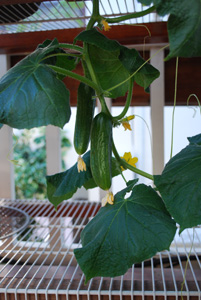

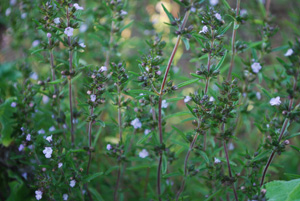
New! Comments
Have a question or comment about what you just read? Leave me a comment in the box below.